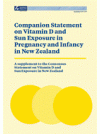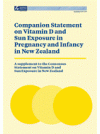This document provides advice for health practitioners on vitamin D and sun exposure in pregnancy and infancy. It identifies those at high risk of vitamin D deficiency and provides recommendations for vitamin D supplementation.
This document complements advice for the general population: The Consensus Statement on Vitamin D and Sun Exposure in New Zealand.
Key Results
Health benefits of vitamin D- Vitamin D helps to maintain calcium and phosphate homeostasis in our body, and optimises bone health and muscle function. Low levels are linked to hypocalcaemic seizures and bone conditions such as rickets in children, and osteoporosis and osteomalacia in adults.
- While vitamin D deficiency during pregnancy has been associated with adverse pregnancy and neonatal outcomes such as being small for gestational age, there is no convincing evidence yet that there is a causal relationship (De-Regil et al 2012). Supplementation during pregnancy has been shown to increase vitamin D levels at the end of pregnancy which is positively correlated to infant vitamin D levels but there is no strong evidence for other outcomes (Cochrane Review by De-Regil et al 2012).
- The recommendations provided in this statement assume the infant or pregnant woman is maintaining an adequate intake of calcium.
Sensible sun exposure
Pregnancy
- For pregnant women, the same sun safety messages apply as for the general population.
- Outdoor physical activity should be encouraged.
- Use of sunbeds/solaria is not recommended.
Infancy
- Sun protection is particularly important for infants. Infants should not be exposed to direct sunlight, particularly between 10 am and 4 pm from September to April.
- Shade, protective clothing, broad-brimmed hats, and sunglasses are the recommended first line of protection against sun exposure in infants and young children.
- When additional sun protection is required, a 30+ broad spectrum sunscreen is considered safe for use. For infants and children with sensitive skin, a chemically inert sunscreen (ie, that uses micronised titanium dioxide and/or zinc oxide) is recommended.
- The Cancer Society recommends testing a patch of skin before applying a previously untried sunscreen to all exposed skin.
- For young children who are mobile, the same sun exposure advice applies as for the general population.


